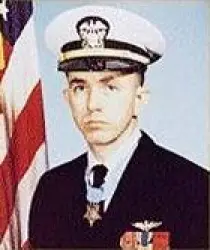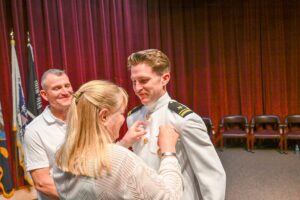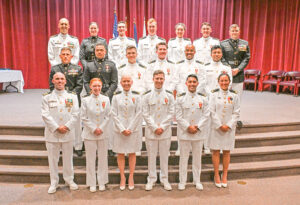Navy Captains Kenneth M. Kerr and Ryan T. Keys, Lt. Colonel Daniel E. Bowring, USMC, and Navy Commanders Darin L. Stockman and James W. Gelsinon all participated in the Training Air Wing Five Naval Aviator Designation Ceremony at NAS Whiting Field in Milton, Florida, last week, when 12 naval officers, two Marine Corps officers and one Coast Guard officer each received their gold wings , bringing the total number of naval aviators to 37837, since the Naval Aviator Wings were ever designed prior to World War I.

The formal ceremony was held in Commander Clyde E. Lassen Auditorium at the Naval Air Station and a dinner party for the aviators followed the formal ceremonies.
Commander Gelsinon commanding officer of Helicopter Training Squadron Twenty-eight welcomed the officers and their families to the ceremony and introduced the guest speaker, Captain Keys.
Captain Keys, a graduate of the US Naval Academy and a retired officer, earned his Naval Aviator wings at Milton in 1997 and served on the staff of Commander, Carrier Strike Four. He also commanded the Dragonslayers of Helantisubron Eleven and deployed in support of Operation Noble Anvil in Kosovo in 1999, as well as Operation Southern Watch, Operation Enduring Freedom and Operation Iraqi Freedom.
Shore side, Captain Keys was an instructor pilot at the Air Force Air War College, commanded Helicopter Sea Combat Squadron Two and the staff of Commander, Navy Region Mid-Atlantic.
Before his retirement in 2024 after 29 years of service, Captain Keys also served as Military Faculty to Joint Forces Staff College in the Joint & Combined Warfighting , and among several awards, received the 2008 Leadership Award for Commander, Helicopter Sea Combat Wing Atlantic Detachment, Jacksonville.
Commander Gelsinon, a native of Tucson, Az., is also a Naval Academy graduate and was designated a Naval Aviator in 2008. He served aboard the USS John Stennis (CVN 74) and was selected with the Blackjacks of Helicopter Sea Combat Squadron Two One as the 2018 Navy and Marine Corps Association Leadership Award winner for Helicopter Sea Combat Wing Pacific. He has accumulated more than 2,4000 flight hours, including 235 combat hours in Iraq.
Captain Kerr is the Commodore of Training Air Wing Five, a graduate of the Naval Academy and also holds a master’s degree in military studies from the American Military University. – Joint School. He accumulated more than 3,900 mishap free flight hours across four airframes.
Lieutenant Colonel Bowring, USMC, is commanding officer of Helicopter Training Squadron 18, a native of Maryland, and a Naval Academy graduate and assumed Command of HTS 18 last October after serving as the Executive Officer and Helicopter Training Squadron 18 executive officer before assuming command. His decorations include the Meritorious Service Medal, Navy and Marine Corps commendation medal with gold star and the Navy and Marine Corps Achievement Medal
Commander Stockman is commanding officer of Helicopter Training Squadron Eight a native of Chesapeake Virginia and a graduate of Drexel University, commissioned through the NROTC program.
He earned his Naval Aviator Wings in 2009 and made his first deployment aboard the USS Dewert (FFG73), participating in Standing NATO Maritime Group Two. More recently, he continued to prepare fleet crews for the Basic phase as the Training Department Head and Operations Department head during a Department Head Tour with HSM-70, the Spartans. He has accumulated more than 2,000 flight hours in seven different aircraft and holds four Navy Commendation and two Navy/Marine Corps Achievement Medal awards in addition to various service awards and ribbons.
The benediction for the designation ceremony was given by Lieutenant LaToya T. Smith, CHC, the Navy Chaplain at NAS Whiting Field.

The 15 new aviators were each introduced, along with their families and family members of each of the officers pinned their aviator amid applause, photographs, and congratulations from the officers who had trained them.
This year provided compliments of the Naval Helicopter Association, date back to the early 20th century when it appeared there was a need for a distinguishing mark for aviators. Army Aviators had worn ‘badges’ in 1913, and others felt Naval Aviators also received recognition.
Several years later, in 1917, a design was submitted for a suitable Naval Aviators recognition design, but it was rejected Several other designs were then proposed and submitted for approval; bronze was rejected in favor of a gold and silver combination. That was changed to an all-gold design and the in October, 1917 the gold wings were approved at just under three inches
It is required that the Aviator’s name, branch of service and Aviator number be engraved , a directive which was discontinued during World War I. The final design, with no stars, and with dimensions modified minimally, the Naval Aviator Wings have changed very little since 1923.

